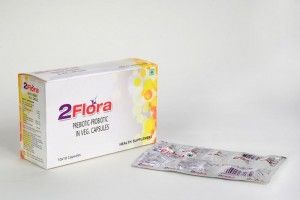2 Flora
Each Capsule contains:
| Lactobacillus acidophilus | 1 billion cfu |
| Bifidobacterium bifidum | 1 billion cfu |
| Fructooligosaccharides (FOS) | 100 mg |
Probiotics are live microorganisms that benefit the health of the host when administered in adequate amounts. Modification of microflora has long been considered as the mechanism of action of probiotics. Several studies suggest that ingestion of certain lactobacilli and bidfidobacteria species decrease the fecal concentrations of Clostridia, Bacteroides, and E coli, and can increase the endogenous levels of lactobacilli and bifidobacteria.
Probiotics are capable of producing short chain fatty acids, which lower the colonic pH, favoring the growth of less pathogenic organisms. Bacteriocins, which are antimicrobial proteins elaborated by probiotic organisms, are especially effective against gram positive organisms.
Binding to intestinal epithelium is one of the determinants in establishing the efficacy of a probiotic. Colonization resistance occurs through this binding, competitively inhibiting adhesion of pathogenic bacteria.
Probiotic bacteria can enhance barrier function by different mechanisms. First, probiotic bacteria like Lactobacillus acidophilus enhance activation of tight junction proteins avoiding the development of a leaky intestine. Second, other probiotic bacteria can prevent inflammation and programmed cell death of the lining intestinal epithelial cells. Finally, an effect on barrier function with a lactobacillus strain has been demonstrated by decreased mucosal permeability to mannitol in germ free rats.
2Flora offers, 2 distinctly superior species: Lactobacillus acidophilus, 1 billion cfu, which colonises in small intestine and proximal colon and Bifidobacterium bifidum, 1billion cfu, which colonises in large intestine (distal colon), the organs from where Diarrhoea originates.
Antibiotics use is always associated with Diarrhoea commonly known as Antibiotic Associated Diarrhoea (AAD). Though it varies with the usage of antibiotics used yet it is prevalent with almost all the antibiotics. Many of the times it leads to discontinuation of antibiotic regimen.
AAD results from an imbalance in the colonic microbiota. Disturbed composition and function of normal intestinal flora, leads to decreased metabolism of carbohydrates, which in turn causes osmotic diarrhoea.
Reduced break down of primary bile acids, further adds on as these are potent colonic secretory agents.
Lower concentrations of fecal anaerobes leads to decrease in colonization resistance. Overgrowth of pathogenic microbes which may produce toxins leads to allergic or toxic effects of antibiotic on intestinal mucosa and pharmacological effect on gut motility.
Lactobacillus acidophilus is a well-researched probiotic, highly resistant to gastric acid, bile salts, and digestive enzymes. It possesses more than 20 peptidases. L. acidophilus readily breaks down casein, casein-derived polypeptides, and gluten. It hydrolyses bile salts and lowers serum cholesterol levels. L. acidophilus ferments lactose and a variety of other sugars and polysaccharides aiding digestion and lowering the pH of intestinal contents.
Bifidobacterium bifidum is the first probiotic that colonizes the digestive system of a newborn child. Its populations are reduced or absent in allergic infants and elderly adults. B. bifidum suppresses total and antigen-specific IgE production and enhances IgM and IgG responses to select antigens. B. bifidum enhances leukocyte phagocytic activity. It can activate B cells making them more responsive for IgA secretion. B. bifidum enhances IgA response to C. difficile toxin A.
Fructo-Oligo-Saccharides (FOS)Prebiotic which ensures rapid establishment of the Lactobacilli in the upper small intestine and Bifidobacteria in the lower small intestine.
Leucorrhoea
denotes a thick, whitish or yellowish vaginal discharge. Leucorrhoea occurs in 5-14% of all the women in the reproductive age group responsible for 5-10 million OPD visits per year. There are many causes of leucorrhea, the usual one being estrogen imbalance. The amount of discharge may increase due to vaginal infection or STDs, in which case it becomes more yellow and foul smelling.
Lactobacillus is a normal resident of the vagina. The low pH of the vagina is attributable to production of lactic acid by Lactobacillus metabolism. Anaerobes grow poorly at pH 4.5 or less; the optimum pH for Prevotella spp and G vaginalis growth is 6–7. Low pH also appears to be important for Lactobacillus adherence to the epithelial cells. At pH of 4.4, a mean of 5.5 Lactobacillus adhered per vaginal cell, compared with 1.4 at pH of 6.2
Lactobacillus acidophilus restores the biological and chemical characteristics of the vaginal ecosystem and also inhibits the growth of C.albicans.
Bifidobacterium bifidum produces acetic acid, lactic acid, and H2O2 which reduces vaginal pH. and also inhibits the growth of C.albicans and E.coli.
Indications
- Antibiotic associated diarrhoea (AAD)
- Gastroenteritis
- Intestinal dysbiosis
- Ulcerative colitis
- Travellers diarrhoea
- Post –operative care
- Leucorrhoea
- PID
- Restoration of Vaginal Flora
- Vaginal Candidiasis
- Recurrent UTIs
Dosage
1 Capsule twice daily.
Presentation
Small sized Vegetarian capsules
Packing
Strip of 10 caps.,Box of 10 strips


